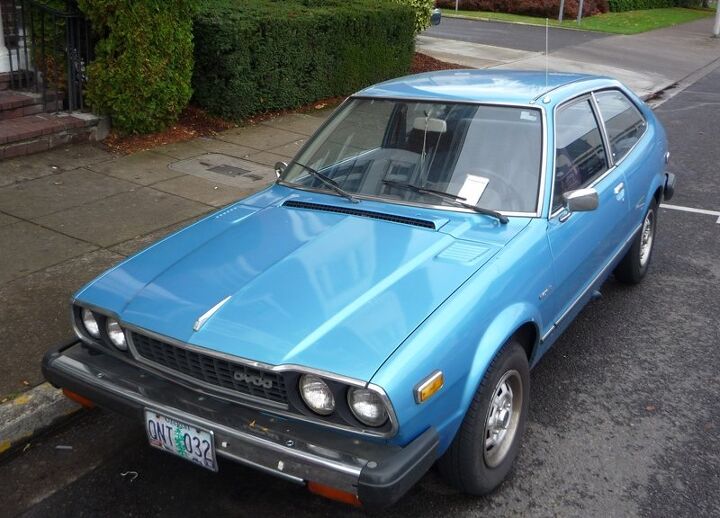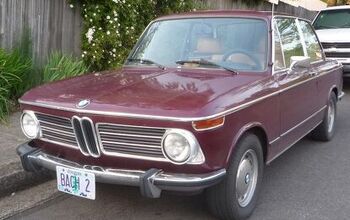Curbside Classic: The Most Influential Modern Car In America – 1976 Honda Accord

This is the companion piece to the Most Influential Modern Global Car: the 1975 VW Rabbit/Golf. Now if I had the same photographic luck as with the Rabbit, there would be a big American car in the same shot, say something like this. Well, the Florence Apt’s [sic] will do fairly well as a stand-in, with its traditional architecture. Because if any one car can take credit for re-inventing the traditional “American” car, it’s this Honda Accord.
Within four years of the Accord’s arrival, GM launched its mega-billion dollar X-Bodies, Chrysler bet its future on K-cars, and Ford eventually came on board with FWD revolution too, in a big way (Taurus). But not only did the Accord start a revolution in Detroit, but also in Japan. The Accord’s effect on Toyota City was like an earthquake that saw the stodgy old mini-Galaxie RWD Corona get dumped for a completely new US-centric FWD Camry. The rest is history, and what a glorious one it is: a record 21 out of 25 years on C/D’s Ten Best Cars list; numerous COTY awards, repeat visits to the top of the US sales charts. Now the Accord is as American as apple pie, literally. From a tiny 2000 lb 68 hp hatchback smaller than today’s Fit, it’s now become a full size car, and not all that different from an updated version of the cars it made obsolete and irrelevant.
Read the middle paragraph on the right side of this ad: “Right here we would like to reassure you on one point. Although we fondly refer to the Accord as the Big Honda, it is only big by our standards. We don’t build what are traditionally called big cars. And we don’t intend to start”. Honda may have been sincere when they said it then, but things obviously didn’t turn out that way. And therein is the fundamental difference between the VW Golf and the Accord: they both started out the same size and basic shape, and although the Golf eventually grew too, its growth was always in low-calorie European terms. The Honda super-sized itself, and became a genuine corn-fed American. Ironically, VW has just now figured that out after thirty years, and is developing “American-sized” sedans to compete with the Accord and Camry. Better late than never, I suppose, but did it really need to take thirty five years to figure out what went wrong?
Speaking of irony, the Accord was originally conceived to be a Mustang-sized car with a V6 engine! Or at least, so goes the legend. It wouldn’t surprise me, since Honda was a very ambitious (actually overly so) company just prior to the Civic. It tended to extreme manifestations of technical superiority, like the brilliant but utterly impossible to build at a profit Honda 1300. But the Civic was a sea change in Honda’s thinking: a revolutionary but pragmatic cheap little hatch, to be built in massive quantities. Honda would never be the same, and the same progressive pragmatism that spawned the Civic naturally took the next step in the Accord, and eventually with cars like the Odyssey, Pilot and Ridgeline. Would anyone have guessed that in 1976? Well, eating ones’ words is a good exercise, and can be highly profitable, in Honda’s case. And the opposite, in VW’s: they’re still bleeding mega-millions in the US.
Regardless of what the Accord was originally meant to be, it came as a very tidy but practical two-door hatch (the four door followed in 1979). Its wheelbase of a mere 93.7 inches was five inches less than a current Hyundai Accent, and it was about the same length overall (160″) as that almost smallest of cars available today. But Americans ate “The Big Honda” up as if it were an apple pie eating contest. It’s difficult to describe just what a huge hit and fad the Accord was when it appeared, unless you were there at the time. The fact that it came just three years after that equally huge hit and fad the Civic, made Honda undoubtedly the fastest growing new brand ever launched in the US. Keep in mind that when the Civic first appeared in 1972, they were being sold in Honda motorcycle dealerships. By the time the Accord hit, Honda car dealerships were licenses to print money.
Everyone raved about the Accord when it appeared. And it hit the market in a very different way then the Golf/Rabbit. VW was still anxious about preserving its vaunted “cheap car” status, and was frantic about offering the Rabbit at a sub $3k price. The only way they did that was by making a special “super stripper” version, with cardboard door panels and rubber floors. The Accord went the exact opposite way: priced at $3,999, exactly one grand (33%) more than the stripped VW, but lavishly equipped like no other car before in its price class. It came standard with a level of equipment unheard of in that time, even for Japanese cars: nicely-upholstered cloth seats, a tachometer, intermittent wipers, and an AM/FM radio. And everyone raved what a great deal it was. VW misread the market completely: Americans were ready to pay as much as a big car for a small one, if it had the comfort, style, pizazz and (most of the) convenience of a big one.
Of course, the Accord’s timing was exquisite, arriving one year after the first energy crisis. But it was more than that; Americans were ready to embrace smaller cars wholesale, especially on the west and east coast. And lets face it, American coupes, typified by the Ford Elite and the like had miserable space utilization, horrible efficiency, were poorly built and wretched to drive. Detroit didn’t just open the portcullis with its obese “mid-sized cars” of the seventies. It actively invited the invasion, and Honda led the charge.
That’s not to take anything away from Toyota’s pioneering and on-going success, but it never had the sudden and almost explosive success Honda did. Toyota had been cultivating its beach-hold since the early sixties, and in 1969 the Corolla became the number two selling import, after the Beetle. Toyota paved the way, identifying the soft underbelly of the beast Detroit. But Honda charged in for the kill, at the right moment, with the right weapon. By the mid-seventies, Toyota’s Corona had become a pretty stodgy affair.
The Accord set the standards for all its future successors to come, if in embryonic form. It was never quite the brilliant and sparkling performer the Golf was, or could be in its best years (or when it was running right or at all). But it had a complete and balanced dynamic that every Accord has had since: a smooth, economical and relatively responsive engine, a slick transmission (don’t ask about the early two-speed automatics though), accurate steering, capable handling, and a consistently high degree of mechanical and assembly quality. No, you won’t find fanatics of early Accords like the Golf Mk.1’s still loyal followers, rebuilding their beloved cars endlessly. Instead, you find Accords still hard at work on the streets (not in the rust belt) like this and numerous other examples hereabouts.
The Accord’s soon to be proven legendary reliability was still largely unknown in 1976. But already then it spoke of a palpable quality of organic wholeness, a car that was as comfortable in its skin as it was to drive. There were no unknowns or surprises in the Accord: what you saw is what you got. Americans could do without the Golf’s Germanic brilliance, because they could smell the risks inherent in that. The Accord was the squeaky clean, cute girl with the winning smile in the local school’s cheerleader outfit next door. She might have been Japanese, but nobody even noticed or cared anymore. They were utterly seduced, and she was assimilated.
And when the Accord’s four door big-sister showed up in 1979, the front doors of suburbia really flew open. In a recent discussion here at TTAC, it was argued that Detroit’s miserable small cars where the cause of its decline. That may have been the case in the heartland, but in the influential west coast, followed all-too soon on the east coast, folks were dumping their big Cutlasses and Monte Carlos for Accords, unless they had a really big family. Anyway, it was the heyday of the multiple car family, so unless one was ferrying a big brood, the two and three Honda car family was quickly taking hold.
The Accord went on to enjoy several years at the top of the charts, until Toyota’s even more-American Camry eventually displaced it. But as we speak, the Accord is likely to reclaim its seat at the top in 2010, once again America’s sweetheart. The fact that it’s now a full sized car makes the Big Honda’s remarkable trip into the hearts of Americans and the near-destruction of Detroit all that much more remarkable and ironic.

More by Paul Niedermeyer
Latest Car Reviews
Read moreLatest Product Reviews
Read moreRecent Comments
- SCE to AUX All that lift makes for an easy rollover of your $70k truck.
- SCE to AUX My son cross-shopped the RAV4 and Model Y, then bought the Y. To their surprise, they hated the RAV4.
- SCE to AUX I'm already driving the cheap EV (19 Ioniq EV).$30k MSRP in late 2018, $23k after subsidy at lease (no tax hassle)$549/year insurance$40 in electricity to drive 1000 miles/month66k miles, no range lossAffordable 16" tiresVirtually no maintenance expensesHyundai (for example) has dramatically cut prices on their EVs, so you can get a 361-mile Ioniq 6 in the high 30s right now.But ask me if I'd go to the Subaru brand if one was affordable, and the answer is no.
- David Murilee Martin, These Toyota Vans were absolute garbage. As the labor even basic service cost 400% as much as servicing a VW Vanagon or American minivan. A skilled Toyota tech would take about 2.5 hours just to change the air cleaner. Also they also broke often, as they overheated and warped the engine and boiled the automatic transmission...
- Marcr My wife and I mostly work from home (or use public transit), the kid is grown, and we no longer do road trips of more than 150 miles or so. Our one car mostly gets used for local errands and the occasional airport pickup. The first non-Tesla, non-Mini, non-Fiat, non-Kia/Hyundai, non-GM (I do have my biases) small fun-to-drive hatchback EV with 200+ mile range, instrument display behind the wheel where it belongs and actual knobs for oft-used functions for under $35K will get our money. What we really want is a proper 21st century equivalent of the original Honda Civic. The Volvo EX30 is close and may end up being the compromise choice.











































Comments
Join the conversation
This is the correct car but it is the wrong year! The 1980 Accord Hatchback was the definitive version of this vehicle. The reason? A bigger more powerful engine that gave it the needed power missing in the earlier versions. This while maintaining the style of the 1976-1979 versions. Great add-ons were air conditioning and a sun roof. Now THAT was a car!!
>> Florence Apt’s [sic] "Apt's" is a contraction of "apartments" -- the apostrophe stands in for the missing letters. So, sic [sic].